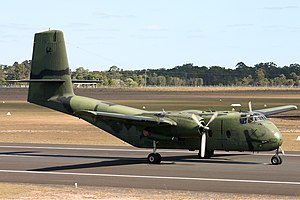Caribou (aircraft)
| DHC-4 Caribou | |
|---|---|
 |
|
| A Royal Australian Air Force Caribou at Bundaberg airport. | |
| Role | STOL Transport |
| Manufacturer | de Havilland Canada |
| First flight | 30 July 1958 |
| Introduction | 1961 |
| Retired |
Royal Australian Air Force (2009) United States Army United States Air Force |
| Status | Retired from military operators, limited service. Some Turboprop conversions in active service |
| Produced | 1958–1968 |
| Number built | 307 |
| Developed into | de Havilland Canada DHC-5 Buffalo |
The de Havilland Canada DHC-4 Caribou (designated by the United States military as the CV-2 and later C-7 Caribou) is a Canadian-designed and produced specialized cargo aircraft with short takeoff and landing (STOL) capability. The Caribou was first flown in 1958 and although mainly retired from military operations, is still in use in small numbers as a rugged "bush" aircraft.
The de Havilland Canada company's third STOL design was a big step up in size compared to its earlier DHC Beaver and DHC Otter, and was the first DHC design powered by two engines. The Caribou, however, was similar in concept in that it was designed as a rugged STOL utility aircraft. The Caribou was primarily a military tactical transport that in commercial service found itself a small niche in cargo hauling. The United States Army ordered 173 in 1959 and took delivery in 1961 under the designation AC-1, which was changed to CV-2 Caribou in 1962.
The majority of Caribou production was destined for military operators, but the type's ruggedness and excellent STOL capabilities requiring runway lengths of only 1200 feet (365 metres) also appealed to some commercial users. U.S. certification was awarded on 23 December 1960. Ansett-MAL, which operated a single example in the New Guinea highlands, and AMOCO Ecuador were early customers, as was Air America, (a CIA front in South East Asia during the Vietnam War era for covert operations). Other civil Caribou aircraft entered commercial service after being retired from their military users.
Today only a handful are in civil use.
PEN Turbo Aviation of Cape May, NJ, announced they would undertake the program of re-engineering the DHC-4A Caribou to the turbine powered variant, now designated DHC-4A Turbo Caribou. The conversion utilizes the PT6A-67 engines and Harzell 5 Bladed HC-B5MA-3M Constant Speed/Reversing propellers. Overall performance has improved and "new" basic weight is reduced while maximum normal take-off weight remained at 28,500 lbs. Maximum payload is 10,000 lbs. Both Transport Canada (11/14/00) and Federal Aviation Administration (2/27/01) have issued Supplemental Type Certificates for the Turbo Caribou. As of Sept 17, 2014, only 3 air frames have gone through the conversion process. PEN Turbo has stockpiled dozens of air frames at their facility in NJ for future conversion. [1]. PEN Turbo Aviation named their company after Perry E. Niforos, who died in the 1992 crash of an earlier turboprop Caribou converted by a different firm, NewCal Aviation.
...
Wikipedia
